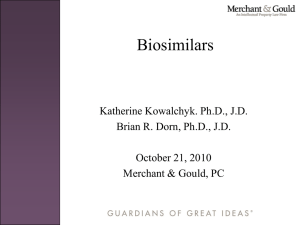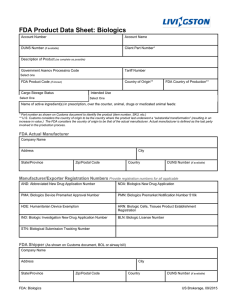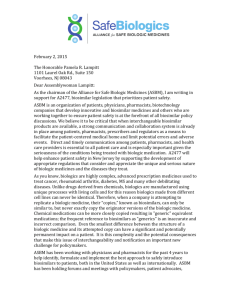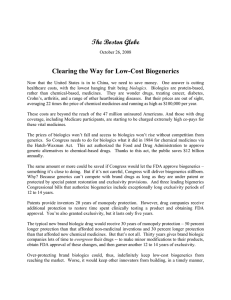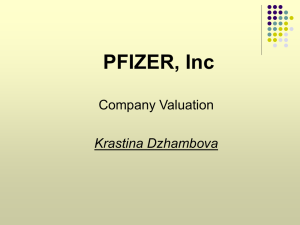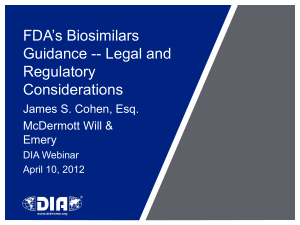approved by the Fda; animal studies that
advertisement
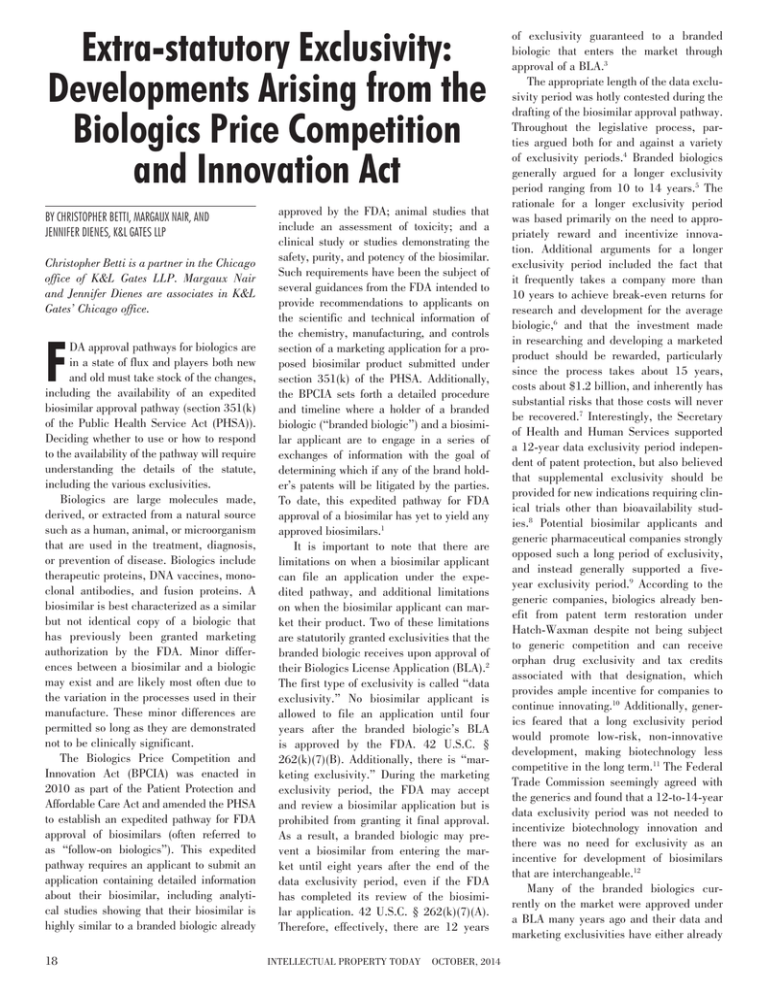
Extra-statutory Exclusivity: Developments Arising from the Biologics Price Competition and Innovation Act By Christopher Betti, Margaux Nair, and Jennifer Dienes, K&L Gates LLP Christopher Betti is a partner in the Chicago office of K&L Gates LLP. Margaux Nair and Jennifer Dienes are associates in K&L Gates’ Chicago office. F DA approval pathways for biologics are in a state of flux and players both new and old must take stock of the changes, including the availability of an expedited biosimilar approval pathway (section 351(k) of the Public Health Service Act (PHSA)). Deciding whether to use or how to respond to the availability of the pathway will require understanding the details of the statute, including the various exclusivities. Biologics are large molecules made, derived, or extracted from a natural source such as a human, animal, or microorganism that are used in the treatment, diagnosis, or prevention of disease. Biologics include therapeutic proteins, DNA vaccines, monoclonal antibodies, and fusion proteins. A biosimilar is best characterized as a similar but not identical copy of a biologic that has previously been granted marketing authorization by the FDA. Minor differences between a biosimilar and a biologic may exist and are likely most often due to the variation in the processes used in their manufacture. These minor differences are permitted so long as they are demonstrated not to be clinically significant. The Biologics Price Competition and Innovation Act (BPCIA) was enacted in 2010 as part of the Patient Protection and Affordable Care Act and amended the PHSA to establish an expedited pathway for FDA approval of biosimilars (often referred to as “follow-on biologics”). This expedited pathway requires an applicant to submit an application containing detailed information about their biosimilar, including analytical studies showing that their biosimilar is highly similar to a branded biologic already 18 approved by the FDA; animal studies that include an assessment of toxicity; and a clinical study or studies demonstrating the safety, purity, and potency of the biosimilar. Such requirements have been the subject of several guidances from the FDA intended to provide recommendations to applicants on the scientific and technical information of the chemistry, manufacturing, and controls section of a marketing application for a proposed biosimilar product submitted under section 351(k) of the PHSA. Additionally, the BPCIA sets forth a detailed procedure and timeline where a holder of a branded biologic (“branded biologic”) and a biosimilar applicant are to engage in a series of exchanges of information with the goal of determining which if any of the brand holder’s patents will be litigated by the parties. To date, this expedited pathway for FDA approval of a biosimilar has yet to yield any approved biosimilars.1 It is important to note that there are limitations on when a biosimilar applicant can file an application under the expedited pathway, and additional limitations on when the biosimilar applicant can market their product. Two of these limitations are statutorily granted exclusivities that the branded biologic receives upon approval of their Biologics License Application (BLA).2 The first type of exclusivity is called “data exclusivity.” No biosimilar applicant is allowed to file an application until four years after the branded biologic’s BLA is approved by the FDA. 42 U.S.C. § 262(k)(7)(B). Additionally, there is “marketing exclusivity.” During the marketing exclusivity period, the FDA may accept and review a biosimilar application but is prohibited from granting it final approval. As a result, a branded biologic may prevent a biosimilar from entering the market until eight years after the end of the data exclusivity period, even if the FDA has completed its review of the biosimilar application. 42 U.S.C. § 262(k)(7)(A). Therefore, effectively, there are 12 years Intellectual Property Today OCTOBER, 2014 of exclusivity guaranteed to a branded biologic that enters the market through approval of a BLA.3 The appropriate length of the data exclusivity period was hotly contested during the drafting of the biosimilar approval pathway. Throughout the legislative process, parties argued both for and against a variety of exclusivity periods.4 Branded biologics generally argued for a longer exclusivity period ranging from 10 to 14 years.5 The rationale for a longer exclusivity period was based primarily on the need to appropriately reward and incentivize innovation. Additional arguments for a longer exclusivity period included the fact that it frequently takes a company more than 10 years to achieve break-even returns for research and development for the average biologic,6 and that the investment made in researching and developing a marketed product should be rewarded, particularly since the process takes about 15 years, costs about $1.2 billion, and inherently has substantial risks that those costs will never be recovered.7 Interestingly, the Secretary of Health and Human Services supported a 12-year data exclusivity period independent of patent protection, but also believed that supplemental exclusivity should be provided for new indications requiring clinical trials other than bioavailability studies.8 Potential biosimilar applicants and generic pharmaceutical companies strongly opposed such a long period of exclusivity, and instead generally supported a fiveyear exclusivity period.9 According to the generic companies, biologics already benefit from patent term restoration under Hatch-Waxman despite not being subject to generic competition and can receive orphan drug exclusivity and tax credits associated with that designation, which provides ample incentive for companies to continue innovating.10 Additionally, generics feared that a long exclusivity period would promote low-risk, non-innovative development, making biotechnology less competitive in the long term.11 The Federal Trade Commission seemingly agreed with the generics and found that a 12-to-14-year data exclusivity period was not needed to incentivize biotechnology innovation and there was no need for exclusivity as an incentive for development of biosimilars that are interchangeable.12 Many of the branded biologics currently on the market were approved under a BLA many years ago and their data and marketing exclusivities have either already expired or are soon to expire for the covered biologics. However, before deciding that no further analysis regarding exclusivities is required, a biosimilar applicant should be aware that there may be additional exclusivity beyond that provided by statute. Notably, branded biologics may be able to receive an additional six months of exclusivity based on the statutory requirement that the biosimilar applicant provide the branded biologic with 180 days of marketing notice (the “extra-statutory exclusivity”).13 42 U.S.C. § 262(l)(8)(A). Biosimilar applicants cannot commence marketing of their biosimilar until expiration of the notice period. In the future, when the BPCIA process coincides with the development of new biologics, it is likely that the extra-statutory exclusivity will overlap with the marketing exclusivity. However, for now, the extra-statutory exclusivity should play an important part in both the branded biologic and biosimilar applicant’s analysis. The extra-statutory exclusivity is triggered by sending the marketing notice to the branded biologic. The exact timing of the notice requirement, and thus, the potential availability of the additional exclusivity are likely to be affected by three currently pending cases. The first case is Sandoz’s appeal to the Federal Circuit from a November 2013 decision dismissing the Sandoz Complaint for Declaratory Judgment and Patent Invalidity and Non-infringement from the U.S. District Court for the Northern District of California. See Docket No. 14-1693. The biologic involved in that case is Amgen’s Enbrel® (etanercept) for which Sandoz has a biosimilar. There are two other cases pending, both involving Remicade® (infliximab). However for the purposes of the exclusivity analysis, the Sandoz case is the most important as the other cases are generally following the Sandoz litigation strategy and the Sandoz case has progressed substantially farther than the other cases, which still remain in the district courts (U.S. District Court for the District of Massachusetts and U.S. District Court for the Southern District of New York). The resolution of the Sandoz case may affect the determination of whether the 180day marketing notice can be sent when the biosimilar application is filed, or whether it is required to be sent only after approval of the application. Biosimilar applicants are advocating for sending notice upon filing, because it is highly unlikely the FDA will be able to approve applications in less than six months’ time, meaning the biosimilar applicant would not have to stay off the market for additional time. Conversely, branded biologics are advocating that marketing notice cannot be sent until the biosimilar application is approved and ready to go on the market, giving branded biologics an additional six-month respite from competition. Regardless of the outcome of the cases, biosimilar applicants will have an incentive to expedite the 351(k) review process as much as possible, which includes sending out their marketing notice as quickly as possible to trigger the additional extra-statutory exclusivity as soon as possible. Conversely, branded biologics will continue to wish to receive the marketing notice as late as possible to maximize the extra-statutory exclusivity to maintain market exclusivity. Branded biologics and biosimilar applicants are likely to use similar tactics and strategies to advance their goals, as are currently seen by parties in ANDA litigation. Whether a company is a branded biologic or a biosimilar applicant, they should be ready to factor additional extra-statutory exclusivity into their analysis and business plans. Endnotes 1. On July 24, 2014, over four years after the enactment of the BPCIA, the FDA accepted its first biosimilar application from Sandoz Inc. (“Sandoz”). Sandoz’s application is for a biosimilar version of Amgen Inc.’s (“Amgen”) Neupogen® (filgrastim). Neupogen® is a pharmaceutical analog of human granulocyte colony stimulating factor that is used to treat neutropenia, a condition where the body does not make enough neutrophils, a type of white blood cell. Amgen’s Neupogen® is indicated for use by patients receiving strong chemotherapy to reduce their risk of infection. Assuming the FDA meets its goal of reviewing 70 percent of new applications within 10 months for fiscal year 2014, as set forth in the FDA’s Biosimilar Biological Product Authorization Performance Goals and Procedures, review of Sandoz’s application will be completed by mid-2015. 2. These exclusivities are based in the BPCIA statue. These exclusivities are different from what may be generally called “patent exclusivity.” Patent exclusivity is the exclusivity a branded biologic may have through its patent rights: that no one may enter the market without risk of infringement until the patents expire. 3. As an illustration, Figure 1’s graph marks out data and marketing exclusivities: 4. Carver et al., An Unofficial Legislative History of the Biologics Price Competition and Innovation Act of 2009, 65 Food & Drug L.J. 671 (2010). 5. Id. at 735, 765, 776, 796-798. 6. Id. at 735. 7. Id. 8. Id. at 762. 9. Id. at 736, 764, 796. 10. Id. at 736. 11. Id. at 796. 12. Id. at 787. 13. The extra-statutory exclusivity is shown in Figure 2’s graph. FIGURE 1 FIGURE 2 Intellectual Property Today OCTOBER, 2014 19
